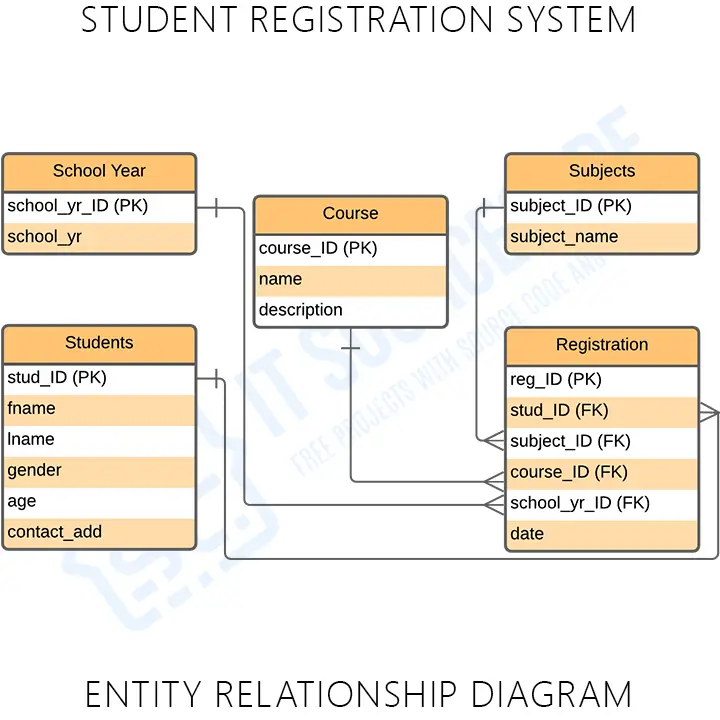The ER diagram for student registration system shows the relationships of the student registration entities and its database design. This describes the logical structure of the system’s database or data storage. It is done by identifying the student registration process entities, their properties, and the interactions between them.
The database design is sketched out using student registration system ER diagrams. This database sketch becomes the actual basis of the system’s data storage that will serve as data destination and source.
Student Registration System ER Diagram: Details
The table shows the overall description of the ER Diagram for student registration System. It has a complete overview of the project’s information.
| Name: | Student Registration System ER Diagram |
| Abstract: | The student registration system ER diagram depicts the relationship between various entities. It can be thought of as a blueprint for your system (project) structure. |
| Diagram: | ER Diagram is also known as Entity Relationship Diagram |
| Tools Used: | Diagraming tools that provide ER diagram symbols. |
| Users: | School Admin, Students, and Registrar’s Personnel. |
| Designer: | ITSourceCode.com |
What is Student Registration System?
The Student Registration System is software that controls every aspect of a university’s daily operations. A structure called a student registration system offers a straightforward way to set up programs for student enrollment.
It was designed so that a student may sign up on their own. In comparison to several forms that students would have to fill out manually, the registration form has been created to be user-friendly and simple to complete, saving both time and money.
Student Registration System Database Design
This Student Registration system database was made based on student registration management requirements. The system can encode the student’s information upon the registration.
The admin can have access to the students’ status as well as their transactions. They can handle the data needed in managing information and records the request made by the students.
The features included in the system ER diagram were the security and monitoring of the school information and students’ information status.
These features were also listed and recorded in reports that served as the history of transactions done in the system.
Student Registration System Features:
- Student Registration – This means that the system can handle and secure the students’ registration transactions including their information.
- Student Information Management – This feature plays a big role for the system because this gathers the important information of the students. This information will be used for determining the choices of the students and assigning them their subjects.
- Manage Courses and Subjects – This system stores the available or offered courses as well as subjects of a certain school. The system lets the student choose their desired course and saves up their information.
- Transaction and Reports Management – This feature will store the transactions made including their information and the reports of every transaction in the corresponding timetables.
ER Diagram for Student Registration System
ER (entity-relationship) Diagram of Student Registration System shows the system entity relationships in each entity and their supposed functions in each relationship.

Based on the image above, the ER diagram for this System is the entity of the Student Registration system database, which is presented by tables; school year, students, course, subjects, and registration.
The tables are made to meet the required specification of the system and provide much more specific details of each entity within the system.
Student Registration System ER Diagram Tables
These tables below provide the complete database table details such as Field Name, Descriptions, data types, and character lengths. Each of these tables represents the characteristics and the attributes of data storage.
The field column presents the names of each database’s attributes, the description column gives the complete thought of each attribute, the type column is their data type and the length is for their character lengths.
Table Name: Student
| Field | Description | Type | Length |
| student_ID (PK) | Student ID | Int | 11 |
| fname | Student First Name | Varchar | 255 |
| lname | Student Last Name | Varchar | 255 |
| gender | Student Gender | Varchar | 255 |
| age | Student Age | Int | 11 |
| contact_add | Customer Contact | Int | 11 |
Table Name: Course
| Field | Description | Type | Length |
| course_ID (PK) | Admin ID | Int | 11 |
| name | Admin First Name | Varchar | 255 |
| description | Admin Last Name | Text |
Table Name: Subjects
| Field | Description | Type | Length |
| subject_ID (PK) | Subject ID | Int | 11 |
| subject_name | Subject Name | Varchar | 255 |
Table Name: School Year
| Field | Description | Type | Length |
| school_year_ID (PK) | School Year ID | Int | 11 |
| school_year | Customer ID | Int | 11 |
Table Name: Registration
| Field | Description | Type | Length |
| registration_ID (PK) | Registration ID | Int | 11 |
| student_ID (FK) | Student ID | Int | 11 |
| course_ID (FK) | Course ID | Int | 11 |
| subjects_ID (FK) | Subjects ID | Varchar | 255 |
| school_year_ID | School Year ID | Int | 255 |
| date | Date | Date |
The tables given will be the basis for developers on how would they do the student registration system database design.
It has the complete description of the database and they will put this into the program or data storage the same as the names given to each of the tables. They will create a database with the attributes given as well as the value of each attribute.
Student Registration System ER Diagram [PDF]
The ER Diagram for Student Registration System in DBMS PDF provides the information explaining the concepts of the project database. You may apply this information to your capstone project. You can also use it directly or modify its content depending on your project’s requirements.
How to create ER Diagram
Time needed: 5 minutes
Steps in building the ER Diagram for Student Registration System with Cardinality Ratio.
- Step 1: Familiarize the ER Diagram (Entity Relationship Diagram) Symbols and Cardinality
Entity Relationship Diagram – shows the structure of data types in a project. It uses symbols to clarify its parts and relationships. Their symbols and applications must be familiarized before you build the ER Diagram.
ER Diagram Symbols:
• Field – are the parts of a table that define the entity’s characteristics. In the database that the ERD models, attributes are commonly thought of as rows.
• Keys – is a technique to categorize data qualities. It is used to organize ER diagrams and assist users in modeling their databases to ensure that they are efficient. This is also used to connect different tables in a database.
– Primary Key: identifies a single entity instance which means a unique attribute or set of attributes.
– Foreign Key: is produced when data attributes have one too many relationships with other entities.
ER Diagram Cardinalities:
The styling of a line and its termination demonstrates cardinality and ordinality.
The greatest number of times an instance of one thing can be related to instances of another entity is referred to as cardinality.
While Ordinality refers to the fewest number of times a single entity instance can be linked to another. - Step 2: Finalize the entities included
Start designing your ER Diagram by finalizing the entities that must be included in your student registration system.
This entity is represented by a rectangle, and you’ll want to leave plenty of room for them in future phases so you may add them to your design.
An entity set is a group of similar entities with shared properties. A table or a table’s attribute is an entity in a database management system.
As a result, by depicting relationships between tables and their characteristics, an ER diagram displays the whole logical structure of a database. - Step 3: Add the attributes of each entity
After finalizing the entities, think about the qualities you’ll need to characterize each entity. The details of the various entities outlined in a conceptual ER diagram are supplied as attributes.
Characteristics of an entity, a many-to-many relationship, or a one-to-one relationship are all examples of attributes. Multivalued attributes can be assigned to several values.
The entity’s attributes were represented by ovals and can be seen in the tables of the student registration system ER diagram. These attributes can be a primary key or a foreign key in the database design of the project. - Step 4: Describe the relationships (cardinality) between entities and attributes
To plot relationships between the ERD you will need the entities, their attributes, and relationships. You will base the data structure from the evaluated information to have the exact Entity Relationship Diagram.
A relationship is an association that describes how two entities interact. At the connector’s endpoints, the cardinality is indicated by a crow’s foot.
One-to-one, one-to-many, and many-to-many are the three most common cardinal relationships. It’s the maximum number of times an instance of one entity can be linked to instances of another entity.
Conclusion:
You need to know the diagrams used to design and develop the Student Registration System. That is to help you create a fully-functional system with the use of ER Diagram. Creating it will help you perceive the back end of the software. This will hold all the data that’ll enter and exit the system.
Related Articles:
- ER Diagram for Online Shopping System
- Loan Management System ER Diagram
- ER Diagram for Online Ordering System
- ER Diagram for Bank Management System
- ER Diagram for Hotel Management System
Recommended Articles From the Author
- Component Diagram for Student Registration System
- Student Course Registration System Class Diagram
- Student Registration System Use Case Diagram
- Student Registration System ER Diagram
Inquiries
If you have inquiries or suggestions about the ER Diagram for Student Registration System, just leave us your comments below. We would be glad to know to concerns and suggestions and be part of your learning.
Keep us updated and Good day!

